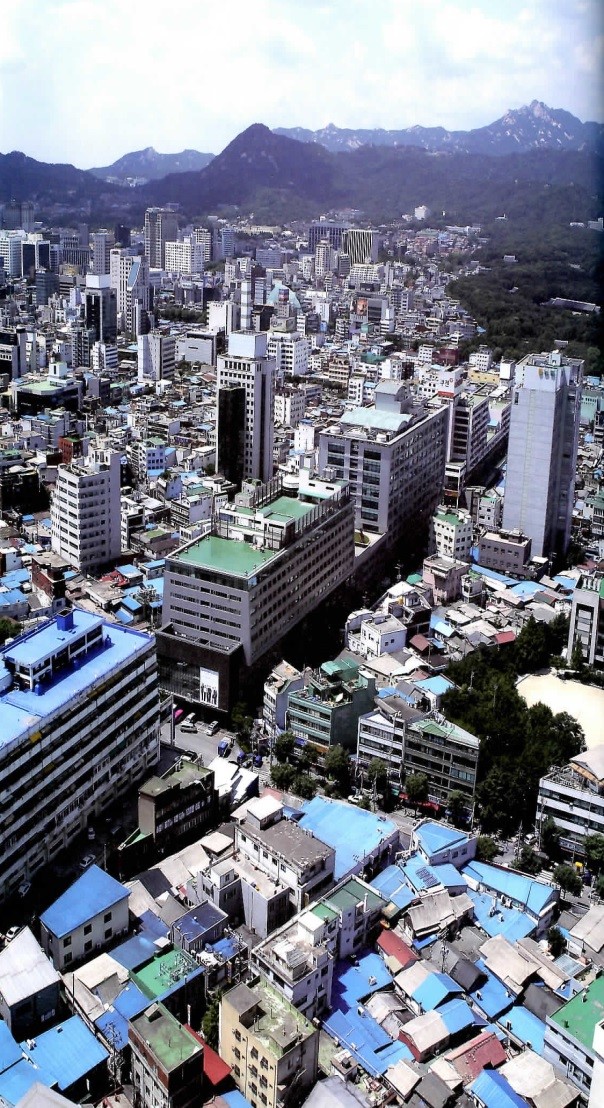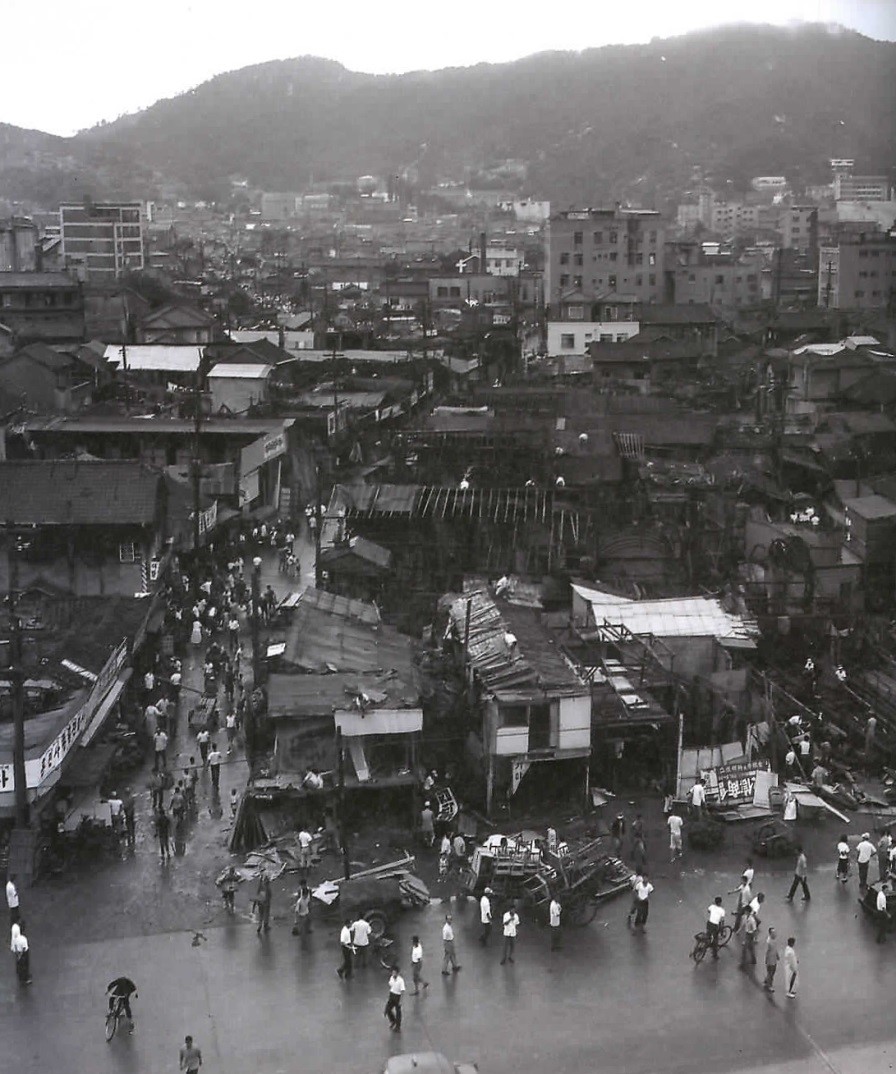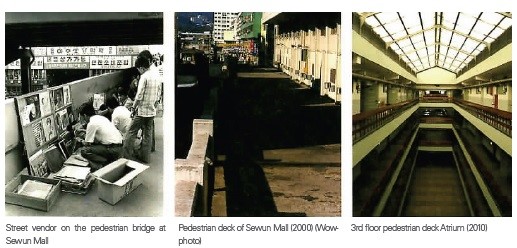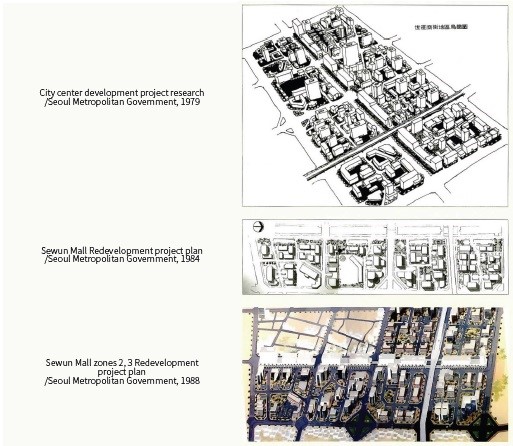Sewun Mall Development Plan
Introduction
The Significance of Sewoon Shopping Center
In 1967, when Korea’s national income per capita stood at just USD 114, a large mall complex with a total floor area of 205,536㎡ and a number of sophisticated 17-story apartment buildings were built along the Cheonggyecheon Stream, an area which until then had been crowded with radio repair shops and brothels. The Sewoon Shopping Center, which extended one kilometer north-south from Jongno to Toegye-ro, was nothing short of a marvel in the eyes of ordinary people. It was Korea’s first large-scale construction project and is still a successful business area even today, although it has been challenged by new competitors such as the Yongsan Electronics Mall and Gangbyeon Techno Mart. While it is notorious as a major source of under-the-counter videos and pornography, it is still known as a place where electronics products and parts are available at the lowest prices.
<Figure 1> A View of the Sewoon Shopping Center

Historical Background to the Sewoon Shopping Center Site
To prevent damage to city infrastructure by possible incendiary attacks by outside forces, the Air Defense Act was revised in 1937. In 1943, regulations were put into place to allow for existing structures to be moved or demolished by force if it was necessary for air defense, to prevent fires from spreading from one building to another. According to these regulations, a vacant lot measuring 50m in width and 1,180m in length between Jongmyo and Pildong would later be designated as the site of the Sewoon Shopping Center.
However, with the collapse of Imperial Japan and the outbreak of the Korean War just five years later, this area was left without proper management and administration, resulting in the construction of many illegal shacks by refugees and fugitives from North Korea. In addition, the number of prostitutes increased in this area, and by the late 1960s they had formed a community called “Jongsam.”
<Figure 2> View of Inhyeon-dong in the 1960s

Design of Sewoon Shopping Center
The Sewoon Shopping Center was planned as a one-kilometer-long pedestrian-friendly mall with a pedestrian deck on the 3rd floor of its constituent buildings. On the first underground level, roads and parking lots were prepared to separate vehicle and pedestrian traffic. To connect the mall with nearby commercial areas in Jongno and Myeongdong, stairs were installed and connected with the pedestrian deck at connection points in Jongno, Cheonggyecheon-ro, Mareunnae-gil and Toegye-ro.
The Sewoon Shopping Center was designed as a business-residential complex, with the 1st to 4th floors earmarked for business purposes and the 5th to 8th floors for apartments. On the 5th floor in particular, an open space was prepared to include a park, a playground and a market. To make the residential space more comfortable, an atrium was built and apartments with terraces were designed.
The complex’s floor area ratio was 300%, but the net ratio—excluding roads—was planned to be as high as 500%. The height of the buildings was restricted to eight floors, although the part facing the arterial roads was permitted to be higher, in the form of a tower, for visual variation. To implement the “city within the city” concept, coffee shops, restaurants and clinics were placed on the 2nd and 4th floors, while lower access and shopping malls were located on the 3rd floor to facilitate pedestrian traffic and sales. In addition, an elementary school was built on the top of a building to complete the complex’s function as a city-like community.
<Figure 3> View of the Sewoon Shopping Center Design

Construction of Sewoon Shopping Center
In October 1966, the SMG signed a design contract for Sewoon Shopping Center Zones A-D with the Korea Engineering Consultants Corporation and went on to select the construction companies. Various construction companies including Hyundai, Daerim, Poongjeon, Shinpoong, Samwon and Sampoong, as well as the unions of landowners including the Asia Business Promotion Association and the Cheonggye Business Corporation, shared the cost of purchasing the city-owned land and built facilities on it for sales and profit.
The Sewoon Shopping Center was constructed in eight sections. The Hyundai Mall Apartments were completed in October 1967, followed in quick succession by the Asia Mall, the Daerim, Cheonggye, Sampoong, Poongjeon, Sinseong and Jinyang Apartments, and a hotel. The entire district was completed in 1968.
Evaluation of the Sewoon Shopping Center
① Positive Outcomes
In addition to general store facilities, the Sewoon Shopping Center accommodated totally new facilities including offices for congresspersons, adult entertainment facilities, churches, saunas, supermarkets, aerobics rooms and indoor golf courses, which created Seoul’s new culture in the 1970s. As the Mall became an increasingly active business area, rent and land prices rose and the apartments on the higher levels gained in value.
② Negative Outcomes
Furthermore, the plan to create an open space to separate and connect the commercial, residential and business functions on the 5th floor was not realized either. Public and convenience facilities, such as a government office, police substation, schools, banks and roof gardens, planned for the “city within the city” concept were not implemented and the atrium and terraces were partly changed from the original plan during construction.
Towards the end of the 1970s, the Sewoon Shopping Center complex became the object of severe criticism. Its unique appearance and size became an eyesore to the city landscape. The green areas stretching from Bukhansan to Namsan via Jongmyo had been cut through, and problems were caused by the vertical separation of traffic with scant consideration for horizontal traffic. This was considered to interfere with Seoul’s city axis and functional connection between the blocks at the ends of the mall, as well as further activation of neighboring blocks.
Background
As the granted land and illegal shacks were left uncontrolled and prostitution proliferated in this area, the need to manage it emerged. Therefore, the Jung-gu Office set up the Daehan Cinema – Cheonggyecheon 4-ga Planned Street Maintenance Plan and submitted a draft plan to the SMG to build roads measuring 20 meters in width in the center, and buildings some 15 meters in width on the sides, of a planned street with a width of 50 meters. However, the SMG rejected this draft plan due to a lack of road capacity and the possibility that existing businesses would incur losses.
After that, the SMG requested O. Negler, a U.S. city planner working for HURPI, to prepare an alternative option for the plan. The alternative consisted of setting up a building area measuring 20 meters in width in the center and roads with a width of 15 meters on both sides. However, Negler’s plan was considered limited in that rearrangement of the land would be very difficult to implement and too much empty space would be generated, thus raising the construction costs.
In July 1966, Seoul Mayor Kim Hyeon-ok studied various options after consultation with architect Kim Su-geun for the design of the Sewoon Shopping Center, and decided to demolish the illegal buildings in Jongno-gu and Jung-gu. At the same time, the city submitted a “Request for Assignment of Redevelopment Districts and Improvement of Poor Developments” to the Ministry of Construction. At the end of August of that year, a site measuring 50 meters in width and 893 meters in length and covering a total area of 44.650m2 was prepared, in conjunction with a strategy for demolishing the illegal settlement while promising compliant occupants the right to apartment residences and warning intractable occupants that the demolition would be enforced. On September 8, a ground-breaking ceremony for the Asia Mall was held. On October 21, the SMG signed a design commissioning contract for Zones A, B, C and D of the Sewoon Shopping Center with the Korea Engineering Consultants Corporation. In November, the resolution to cancel the planned street measuring 50 meters in width and to assign the improvement districts of poor developments was passed by the central city planning committee.
Progress
Functional Decline of the Sewoon Shopping Center and Discussions on Redevelopment
① Functional Decline
In the 1970s, Shinsegae, Midopa and Lotte Department Stores were opened in Myeongdong and the place became Seoul’s core business area once again, ultimately resulting in the decline of the Sewoon Shopping Center. The newly opened department stores became high-end business places, causing general stores in the Sewoon Shopping Center to suffer further damages. At the same time, electronics goods, sound equipment and musical instruments, which the Sewoon Shopping Center traded in, were classified as items inappropriate to be sold in the city center, and the relevant businesses were forced to move to the Yongsan Electronics Shopping Center, causing a dramatic decline in the fortunes of the Sewoon Shopping Center.Due to this decline, the apartments on upper stories of the mall became occupied by small businesses. Hangang Mansions and other large apartment complexes were built in Gangnam beginning in the early 1970s, and the residents of the Sewoon Shopping Center began to move there. At the same time, the mall’s residential function declined sharply as its main purpose gradually switched over mainly focusing on business.
②Redevelopment Plan Established as a Solution to Functional Decline
A plan was suggested to redevelop the old Sewoon Shopping Center and its vicinity and restore the CBD function of the city center. The idea was to move the electrics and electronics businesses to the suburbs and introduce business and cultural facilities in this area in a bid to totally renovate the district. It also proposed the creation of green areas vertically from Jongmyo to Namsan and the installation of a pedestrian path. The roads were also going to be significantly improved, with the construction of an 30-meter-wide arterial road in the east to connect the mall with Namsan Tunnel No. 1, and a 10-meter-wide pedestrian path linking green areas and the shopping mall in the west, while the road under the deck would be used as a parking area. Along with that, connecting decks were planned to connect the mall within the vicinity. However, the land lots were too small and it proved difficult to obtain the consent of the landowners. Therefore, a plan was suggested to enable the development of small lots, while a small lot separation plan and block development were encouraged.
The plan suggested in the City Center Redevelopment Project Plan Research: Sewoon Shopping Center Area (1979) was nullified due to the failure to make a cadastral notification. The Ministry of Construction again set up a redevelopment project plan for only the eastern part of the mall in 1982. This plan suggested landscaping of the deck area to complement the green areas and create a rest area to attract pedestrian traffic. Additionally, a large parking lot was to be prepared to make the business area more active. Plans were set up to improve the inside of the buildings and convert them into officetels and residence hotels.
As the west part of the mall was designated as a new redevelopment district in 1987, the existing plan was readjusted, and new zones were added under the new redevelopment project plan. This plan proposed that the Sewoon Shopping Center be left as it was, and the functions of the vicinity activated. The scope and density of the project was to build a new building similar to the existing Sewoon Shopping Center, which was medium-size (within 3,305.8m2) and medium-height (5-10 floors).
To harmonize the horizontal arterial road and the Sewoon Shopping Center buildings, the construction line on both sides of the 25-meter-wide road was moved backward, and public green areas were set up to complement the green areas. Beyond each road, a park was planned, along with underground public parking areas. The deck of the Sewoon Shopping Center was landscaped as a pedestrian path and connected with nearby business areas. Also, as suggested in the previous plan, the roads on both sides of the mall were converted into a 25-meter wide, one-way road. However, given that the lots were small but owned by a large number of landowners, it was suggested that a redevelopment union be formed and a total development method be used as an improvement on the land division development method.
<Table 9> Redevelopment Plans for the Sewoon Shopping Center and Its Vicinity
| City Center Redevelopment Project Plan Research: Sewun Mall Area (1979) | Sewun Mall District Redevelopment Project Plan (1984) |
Sewun Mall District, Sewun Mall Zones 2 and 3 Redevelopment Project Plan (1988) |
||
| Scope | § East and west areas of Sewun Mall | § East area of Sewun Mall | § West area of Sewun Mall, Zones 2 and 3 added to the ‘84 plan | |
| Purpose | § Restoration of the new city center CBD function | § Total reorganization of purpose and structure for activation of Sewun Mall | § Preservation and activation of Sewun Mall § Public function enhanced after development |
|
| Main Goals | Green areas creation | § Creation of green areas vertically considering the pricing of the city center between Jongmyo and Namsan | § Addition of city parks and pedestrian paths to complement metropolitan green areas axis § Landscaping of the midair path deck to complement the green areas axis |
§ Putting the construction line of the horizontal arterial road 25 m in width backward to strengthen the green areas axis |
| Pedestrian path building | § New addition of a pedestrian path 10 m in width on the west side of Sewun Mall § Connection of Sewun Mall deck with nearby developments |
§ Activation of the midair pedestrian deck and creation of a resting area | § Use of the midair deck as a pedestrian-only space § Smooth course planning with the business district |
|
| Road and parking facility | § Installation of an arterial road 30 m in width on the east side of Sewun Mall and connection with Namsan Tunnel No. 1 § Expansion of Euljiro width § Use of the midair deck and road underneath as the parking area |
§ Expansion of Baeogaegil and connection with Namsan Tunnel No. 1 § Reduction of function of the arterial road 30 m in width on the east side to the district access road § Preparation of a large parking area to activate business |
§ Planning of a mid-sized one-way road 25 m in width on both sides of Sewun Mall | |
| Other | § Building a shopping mall on the west side of Sewum Mall to expand its business function | § Internal improvement of the Sewun Mall | § 3D design rather than planar design | |
| Method of implementation | § Small lot division plan | § Land division and organization method § Effect of total purchase induced |
§ Land division and organization method § Total redevelopment |
|
<Figure 4> Sewoon Shopping Center Vicinity Redevelopment Plan

Conflicts over the Sewoon Shopping Center Reorganization Promotion Plan
① Background and Details of the Sewoon Shopping Center Reorganization Promotion Plan
However, certain stakeholders disagreed over the redevelopment plan. The International Council on Monuments and Sites (ICOMOS) pointed out that the plan needed to be changed to preserve the cultural landscape of Jongmyo. Accordingly, the SMG and Jung-gu Office created guidelines for Sewoon Zone 4 to resolve the conflict with ICOMOS. Meanwhile, the Jung-gu Office conflicted with the SMG regarding the height restrictions of skyscrapers. The SMG later promised to review the matter and alleviate the restrictions if possible, thereby resolving the conflict. A conflict also arose between the SMG and the Office of Education over the preparation of sites for new schools in the district. This conflict, however, was resolved when the Office of Education accepted the plan to establish an additional elementary school on the Ducksu Middle School site. With this, all the conflicts were resolved, and the Sewoon Reorganization Promotion Plan was confirmed in March 2009.
② Conflicts with ICOMOS and Resolution: Jongmyo
After that, three meetings were held to obtain advice, and the plan was adjusted. Jongno-gu pointed out that the delay of the construction work due to the height restriction for Jongmyo was increasing the financial losses of the landowners, and argued that the existing plan be adhered to in order to ensure that the project could be completed as soon as possible. At this point, ICOMOS-Korea suggested that the height restriction be reconsidered, and asked the SMG and Jung-gu Office to allow the maximum height as presented in the basic city and residential environment reorganization plan. It also suggested that part of the upper floors be used as various cultural facilities. The Jung-gu Office accepted these suggestions and adjusted the height of the buildings, and also changed some of the residential facilities in the block to business facilities to make up for the reduction of business facilities caused by the height adjustment.
③ Conflicts with Jung-gu Office and Resolution: Height Plan
Jung-gu submitted this plan and introduced the “City Regeneration and Role of Skyscraper Construction,” promoting the need for skyscrapers. It also suggested that it would be possible to create a large open space by allowing the construction of skyscrapers. However, the SMG made it clear that it would adhere to the existing height restrictions. Conflicts between Jung-gu and the SMG thus intensified as Jung-gu independently collected ideas for skyscrapers, promoted them through the media, and formed a civil committee to request the removal of height restrictions in Jung-gu. Later, the SMG held negotiations with Jung-gu and agreed to consider alleviating the height restrictions to enable high-rise construction in Jung-gu, and reflect this in the Sewoon Reorganization Promotion Plan.
④ Conflicts with the Office of Education and Resolution: Provision of Schools
Accordingly, the SMG explained that the applicable laws required the superintendent to establish a plan to purchase sites for the schools and that the account of the project operator would pay the expenses as per the plans drawn up by the Ministry of Education and Human Resources. The SMG also requested the establishment of a feasible school installation plan, noting that it was not possible to insist that the developer pay for the school site since the land price in the area of the school was KRW 50-100 million per 3.3m2.
After that, the SMG and the Central Office of Education held four further rounds of negotiations before agreeing on a decision to draw up a plan for Sewoon reorganization promotion within the scope of the regulations on school establishment. As a result, it was decided that the plan to standardize the site for Ducksu Middle School and establish an elementary school on a separate site was feasible.
Results
Changes to the Sewoon Reorganization Promotion Plan and Future Plan
Later, the SMG organized an expert T/F team with the participation of Jongno-gu, Jung-gu and SH, and conducted fourteen discussions on the Sewoon Reorganization Promotion Plan. It also conducted research on the reorganization plan and interviewed residents 15 times, building a consensus on the need to change the promotion plan and development directions. Finally, the SMG cancelled the existing plan in 2009 and announced the Revision of the Sewoon Reorganization Promotion Plan in 2013. Later, in 2014, the Revision of the Sewoon Reorganization Promotion Plan was confirmed and announced.
① Main Points of the Revision
The height of the new structures where Jongno and Toegye-ro meet was reduced from 90 to 70 meters, in consideration of the cultural heritage of Jongmyo, and the landscape of Namsan. The building coverage ratio was revised from 60% to 80% for zones where horizontal activation was needed or where it was difficult to secure a certain floor area ratio. The floor area ratio was 600% for the city center business area, but under the floor area ration incentive program, 100% incentive was given for the city center industrial activation area, and 200% incentive for the area where the purpose needed to be converted. Also, the plan to add an elementary school was cancelled, and it was decided to keep the current Ducksu Middle School.
② Plans and Operation
References
- Jeon, Wu-yong and six others (2001), Cheonggyecheon: Time, Place and People, Institute of Seoul Studies
- Kim, Jin-ae (2003), Praise Our City, Ahn Graphics
- Seoul City (2009), The Records of the Sewun Reorganization Promotion District
- Seoul Museum of History (2010), The Sewun Mall and Neighborhood